After finding the location of Holy Trinity for last week’s post, I walked to another location just off Minories which was my main reason for visiting the area. I wanted to find the location of the photo my father had taken of America Square in 1949.
The photo was taken at a bit of an angle and does not show the full view of America Square. The photo appears to be looking across to the far side of the square. There is an obelisk to the right, in front of a bridge, which carries the railway into Fenchurch Street Station which is to the right.
As could be expected, the area has changed significantly, and this is America Square in 2019:
The following photo shows where a street leading from America Square heads underneath the railway bridge. The obelisk would have been just in front of the bridge and to the right of the street.
America Square was built between 1768 and 1774 as part of a development which extended from America Square, south towards Tower Hill. The architect was George Dance the Younger who worked for the developer of the estate, Sir Benjamin Hammett.
The square consisted of 16 residential houses. The northern edge along what was John Street (now Cross Wall) was the only side of the square without any development.
The name America Square was a reference to American traders in the City of London, or possibly to attract these traders to purchase the houses.
The East London Observer on the 28th August 1915 provides some detail on the American association:
“America Square in John Street, Minories, in the middle of the last Century, wast the Rialto an open-air club of the officers of the beautiful sailing vessels from the States, which, for a time, outclassed the British commercial marine on the Atlantic, and filled the London and Liverpool Docks. The outbreak of the Secession Civil War brought many changes; the long blockade of the Southern Ports rid England for a full generation of a dangerous rival in international ocean trade. The ‘skimmers of the sea’ disappeared from the Atlantic or changed into armed blockade-runners and privateers; the dashing dandy Yankee and Charleston captains were improvised into Admirals of the improvised Navies of the North and the South, and found a seaman’s grave; the glory, bustle, gaiety and profusion of America Square departed.”
On an overcast Saturday morning in America Square, it was hard to imagine it as a place of ‘glory, bustle, gaiety and profusion’.
It is also hard to really appreciate how many people have walked the same streets over the centuries and the random events that connect London streets with the rest of the world. Newspapers from the last couple of centuries are full of the usual range of adverts, positions vacant, sales, passages on ships available, imported goods for sale, births, deaths and marriages etc. all with an address in America Square. On the basis that only bad news is salable news, there are also many stories of tragic and criminal events taking place.
The first reference to America Square in the newspapers is from the 16th February 1773 when John Stainbank, of America Square, Lead Merchant was included in the weekly list of bankrupts.
In the London Evening Standard of the 16th April 1863 there is a reference that a “Frederick Walker, a shrewd-looking young foreigner, was charged with robbing a hotel in America Square”.
One of the hotels in America Square was Kroll’s Hotel and an unfortunate resident was the main suspect in the Great Coram Street murder of Harriet Buswell at 12 Great Coram Street in December 1872.
Dr Henry James Bernard Gottfried Hessel was traveling from Germany to Brazil in the ship Wangerland when the vessel became stranded on the Goodwin Sands. The shipped was floated, but taken into Ramsgate for checks and repairs. Dr Hessel and his wife first stayed in a hotel in Ramsgate then traveled to Kroll’s Hotel in America Square.
In a case of mistaken identity, Dr Hessel was arrested and charged with the murder. The lack of any firm evidence, contradictory prosecution evidence and the support of those who knew Dr Hessel resulted in him being found not guilty, as the judge’s summing-up reported by the Morning Post on the 31st January 1873:
“This case has been most fully investigated here, and the witnesses on both sides have been subjected to a close and searching cross-examination, and I am satisfied that the witnesses who have spoken to the identity of Dr Hessel are entirely in error. But even supposing that their evidence had been stronger and free from discrepancies, i should have considered that the case on the part of the prosecution had been entirely destroyed by the evidence of the witnesses for the defence. It is therefore my duty, and a duty with which I discharge with great satisfaction to myself, to state that the prisoner is released, as far as I can see, and I can say that he leave this court without suspicion.”
Poor Dr Hessel – finding yourself stranded on a sandbank off the Kent cost resulting in an unexpected stay in a country which you did not expect to visit, then finding yourself on a charge of murder – a travelers nightmare.
The 1895 Ordnance Survey Map shows America Square, just above the railway shown running across the middle of the map.
Credit: ‘Reproduced with the permission of the National Library of Scotland’
America Square originally extended further south than its current boundary with the railway, however building of the railway in 1841 started the process of chopping bits of the square as the railway expanded.
The City Press on the 28th January 1860 reported that the London and Blackwall Railway Company had applied for an Act to enable them to provide additional station accommodation, along with other works on the northern side of the existing railway. The report stated that “The public ways proposed to the absorbed or partially interfered with by the scheme, are Gould-square, America-square, Hanover-court, the Minories. The railway is to be carried on arches through the City, and those arches which already span the public ways of Vine-street and the Minories will practically be widened by the addition of others at the side of them.”
The impact on America Square can be clearly seen in the 1895 Ordnance Survey map.
The London Metropolitan Archives, Collage collection has a number of drawings and photos that help tell the story of America Square.
The first is a drawing by Thomas Colman Dibden from around 1850, showing the square when it was still surrounded by the original 18th century houses. The obelisk features in the centre of the drawing, and supports a couple of lanterns hung on either side.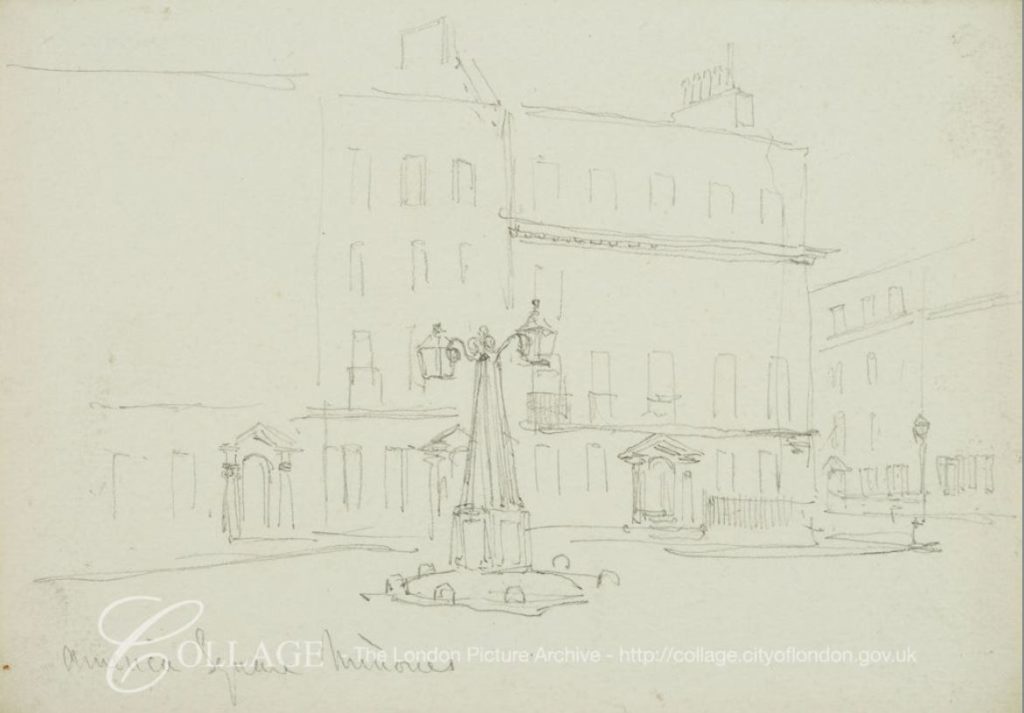
Image credit: London Metropolitan Archives, City of London: catalogue ref: v9010129
The following direction of view of the following photo is very similar to my father’s photo, however the scene is very different.
Image credit: London Metropolitan Archives, City of London: catalogue ref: m0017453cl
The photo shows America Square in 1944, soon after being hit by a V1 flying bomb. The buildings on the eastern side of the square consisted of offices for the railway’s goods yards and a parcels office. Rubble was strewn across the square, but the obelisk has survived.
This explains the state of the buildings in my father’s photo, and possibly why he photographed the scene.
The following photo from 1957 shows the obelisk still in place, but looking in rather poor condition.
Image credit: London Metropolitan Archives, City of London: catalogue ref: m0026573cl
I could not find exactly when the obelisk was removed, and I assume it was destroyed. I suspect it was during the 1980s when the buildings on either side of America Square were developed.
There were many pubs around America Square, but they have now all disappeared. The building of one remains, directly opposite America Square on the junction of Crosswall and Vine Street.
This was the Angel and is shown in the 1895 Ordnance Survey map. The pub closed in 2006 and it is now a bar / restaurant called the Missouri Angel – continuing the American links of the area.
After exploring America Square, I walked under the railway to explore another part of George Dance 18th century development.
I always find the tunnels under London’s railways oddly fascinating. Look to the upper right and at the top of the wall is a street lamp with the red cross from the coat of arms of the City of London.
The streets on either side of the railway are tarmac, however the part of the street under the railway is still cobbled.
There are some interesting alleys leading off from the streets south of America Square:
Looking back through the tunnel under the railway towards America Square:
A very short distance south of America Square is the next part of George Dance and Sir Benjamin Hammett’s development that I wanted to find. If you go back to the 1895 Ordnance Survey map, you will see just below the railway is a semi-circular development called The Crescent.
In an area that consists of steel and glass office buildings from the 1980s onward, The Crescent is a rather unique place, not on any direct walking route, reached through a small street that leads from the Minories and from America Square.
The original buildings were badly damaged by bombing during the last war. The damage started with total destruction on the right and progressively reducing along the buildings to the left.
Pevsner’s guide to the City of London explains that there were originally 11 houses, and only numbers 6 to 11 can be seen today. Numbers 6 and 7 (the two on the left of the terrace) retain their original doorcases. The facades were extensively restored in 1985-6 when replicas of numbers 8 to 11 (the houses to the right) were built.
Although only two originals survive (with much restoration), it is good to see that George Dance’s crescent design can still be seen, having avoided being replaced by yet another glass and steel block.
The London Metropolitan Archive, Collage site includes a photo of the Crescent in 1913:
Image credit: London Metropolitan Archives, City of London: catalogue ref: SC_PHL_01_008_79_4342
There is still more to explore here. There is a remarkable section of the Roman wall in the basement of One America Square. It was excavated in the late 1980s, but had been found much earlier. The reference to America Square in the 1927 edition of London by George H. Cunningham records that “In 1908 a large portion of Roman wall was discovered here”. A topic for a future post with a bit of Roman wall exploration.

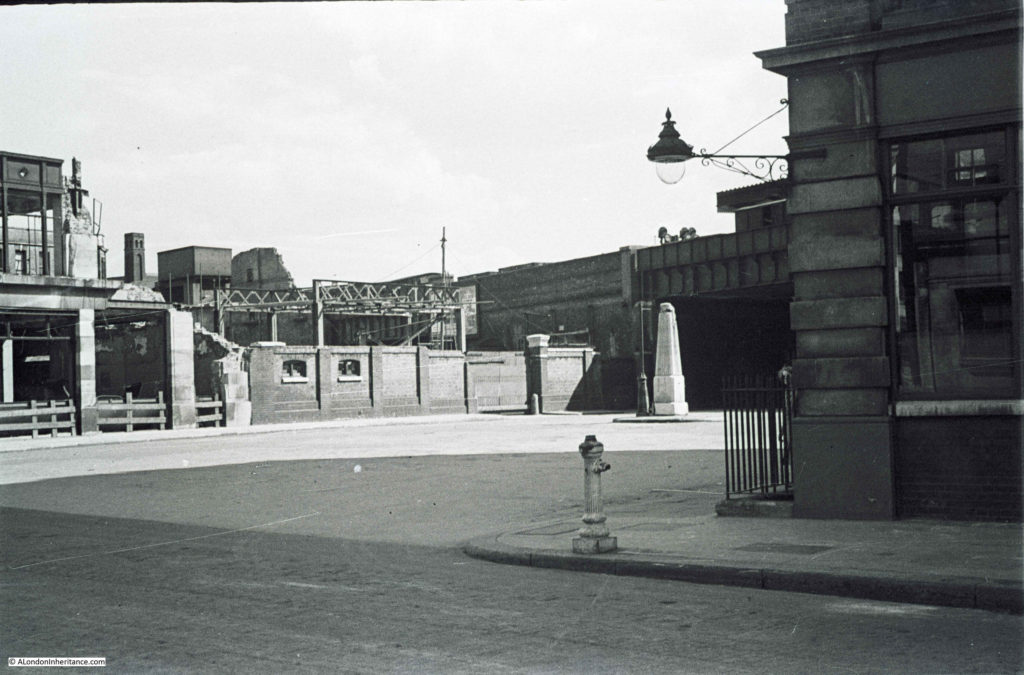
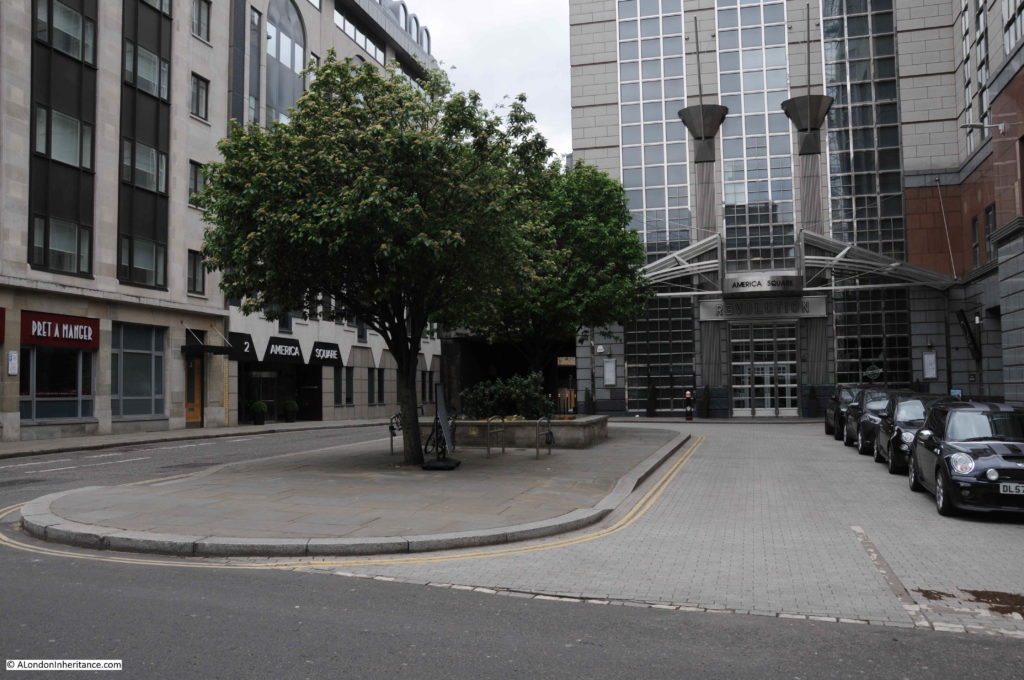
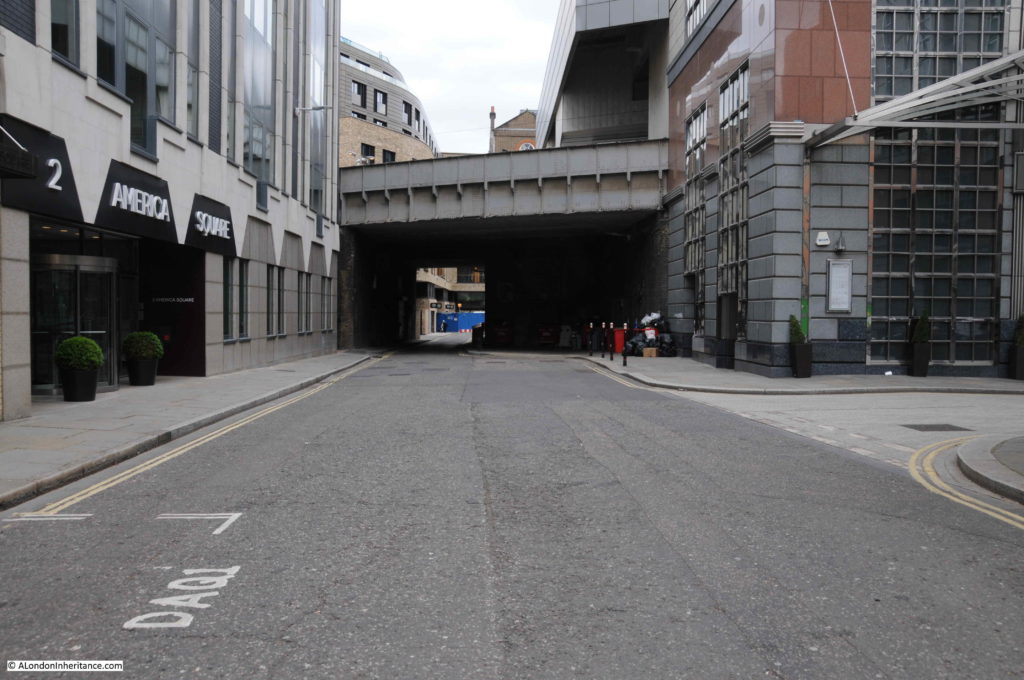
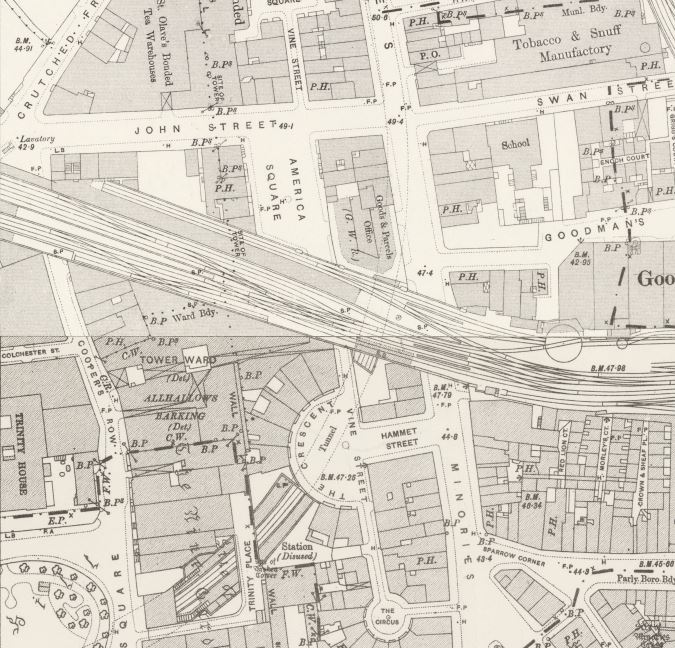
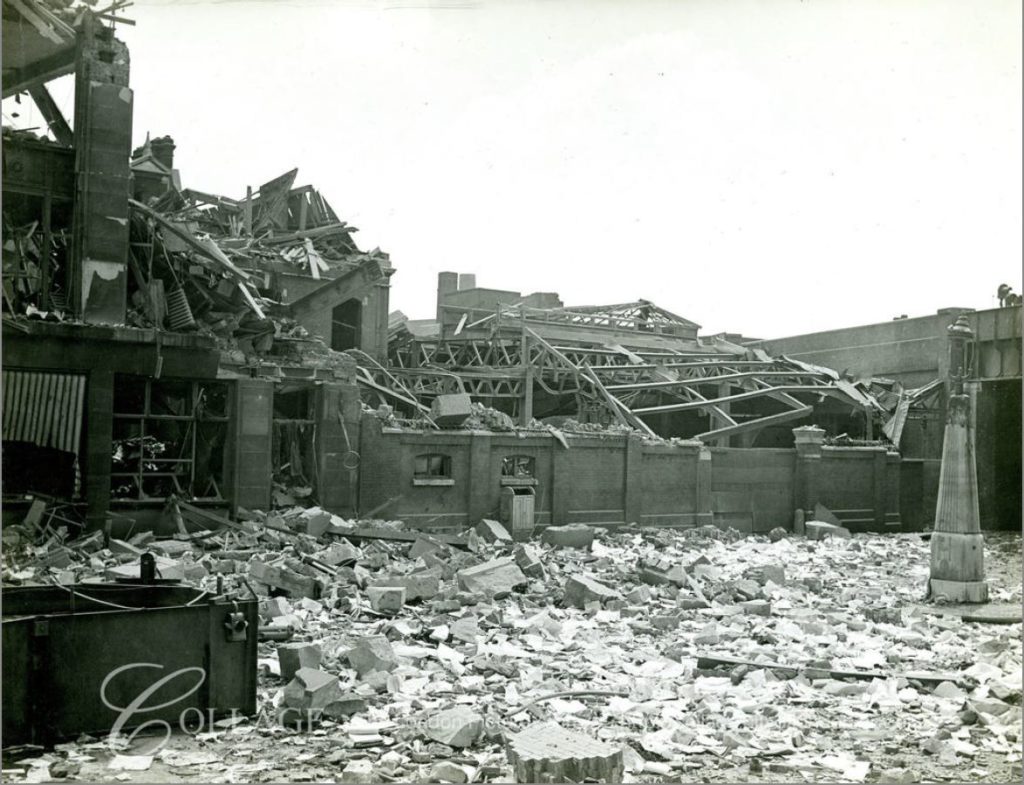
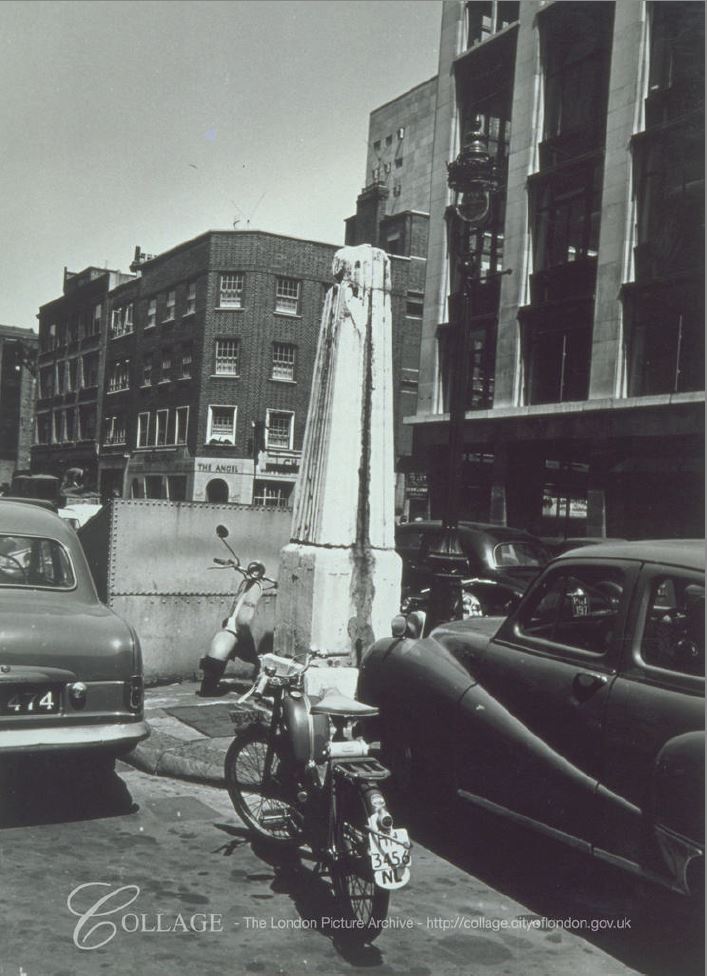
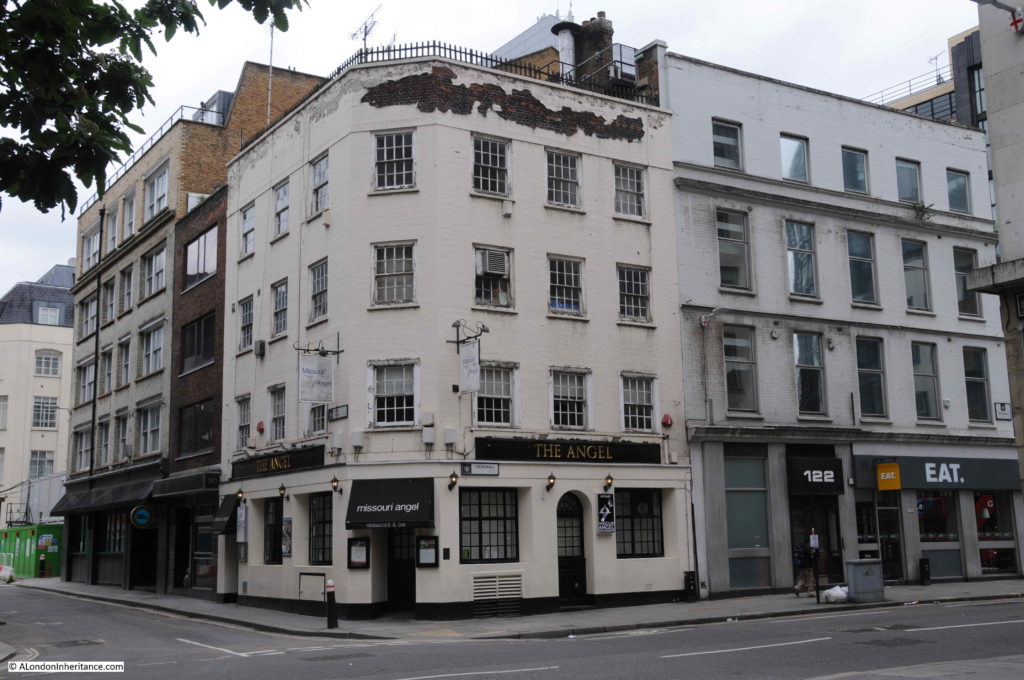
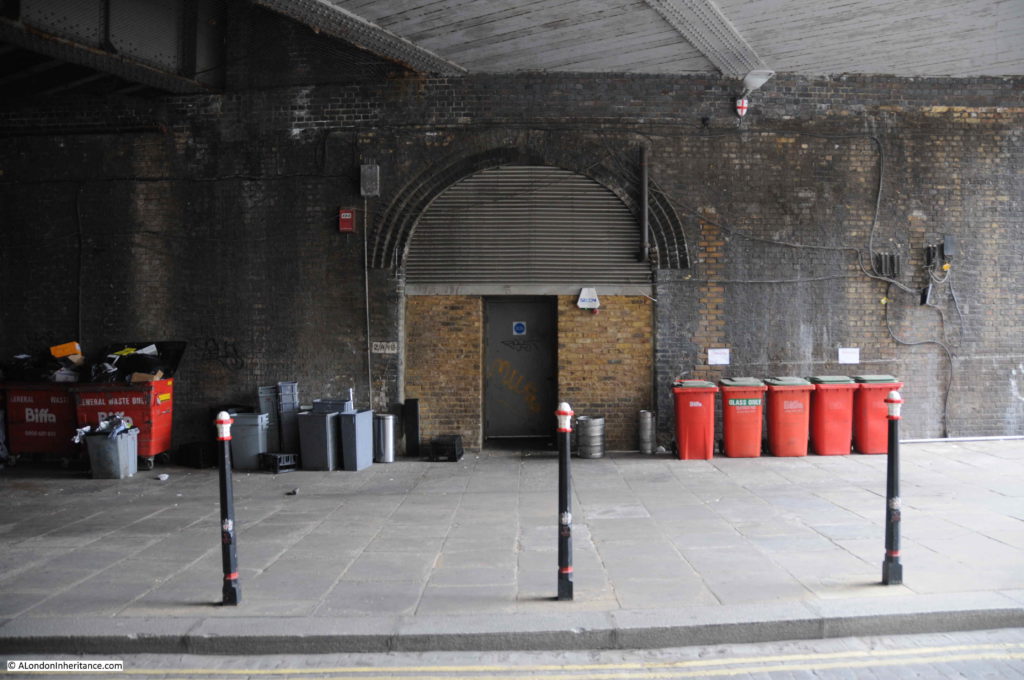
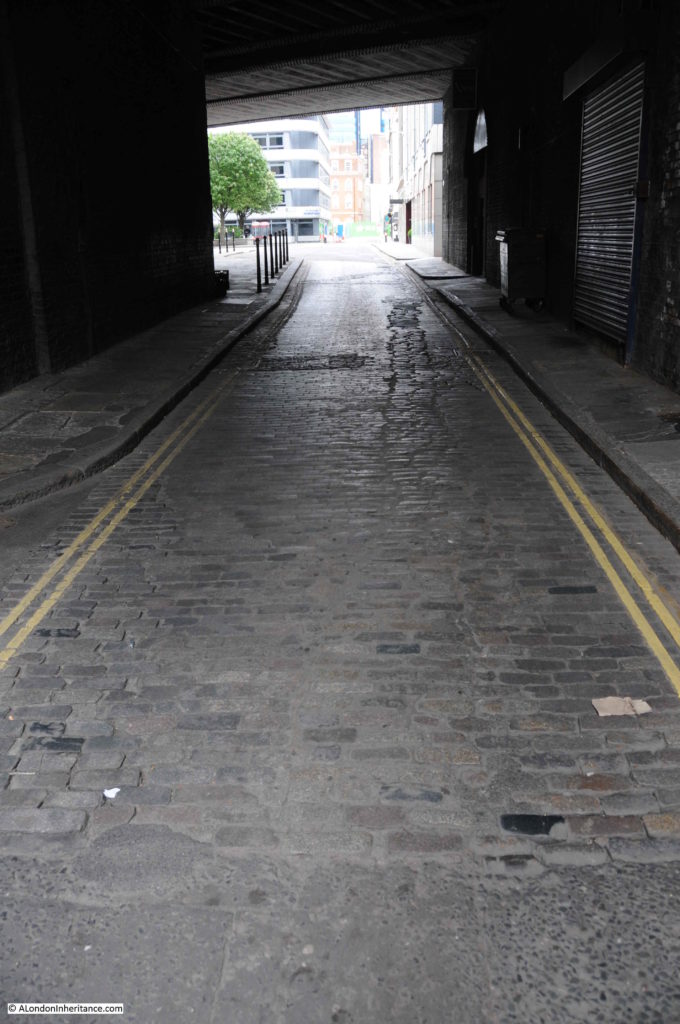
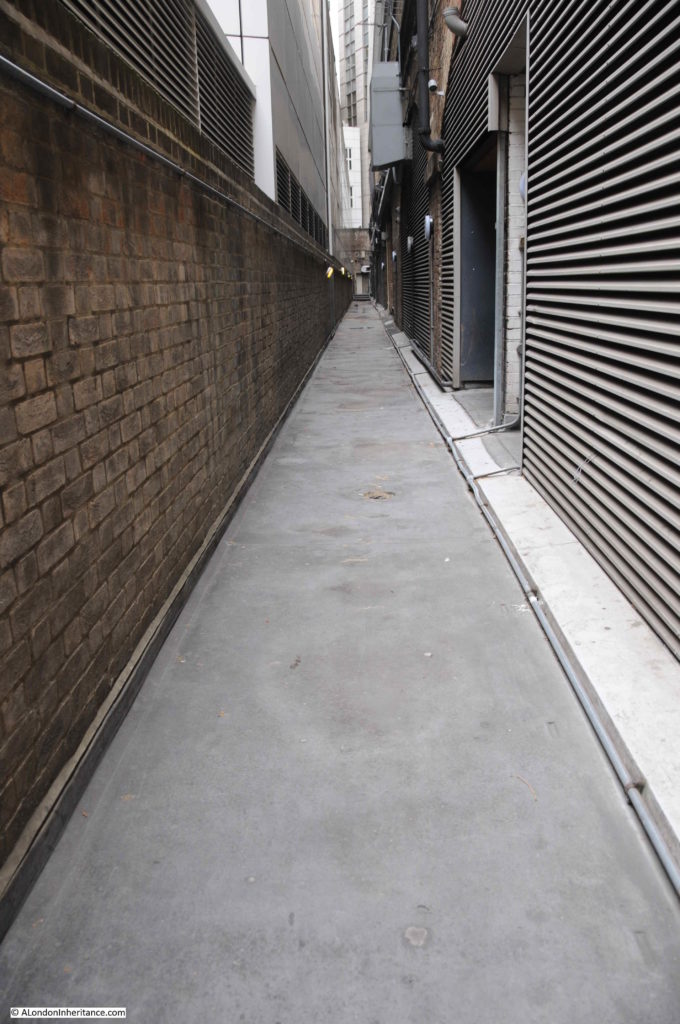
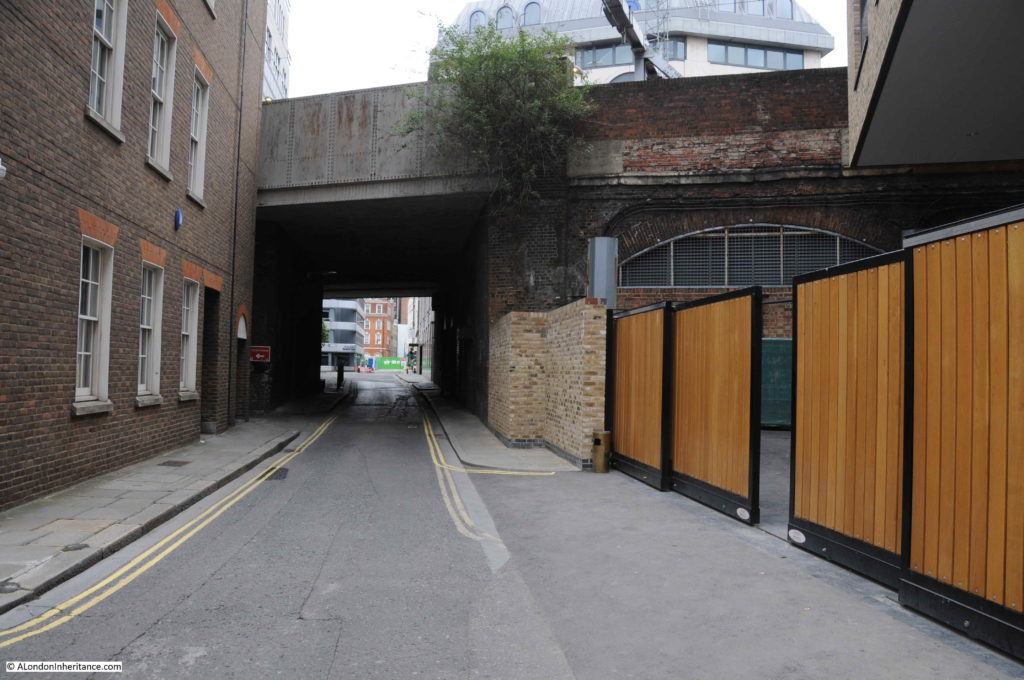
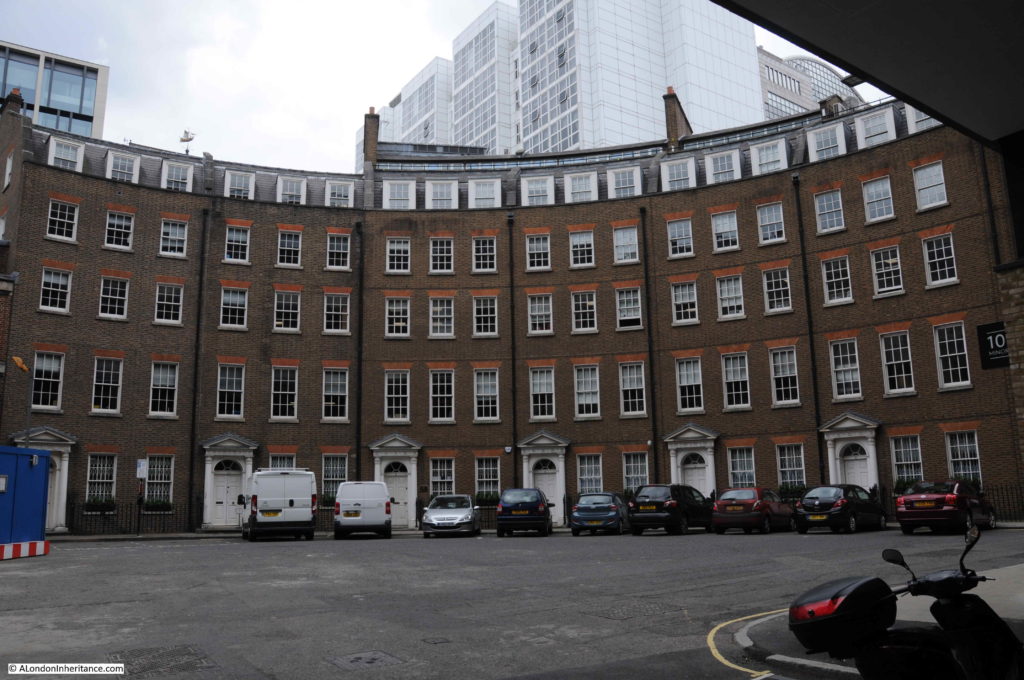
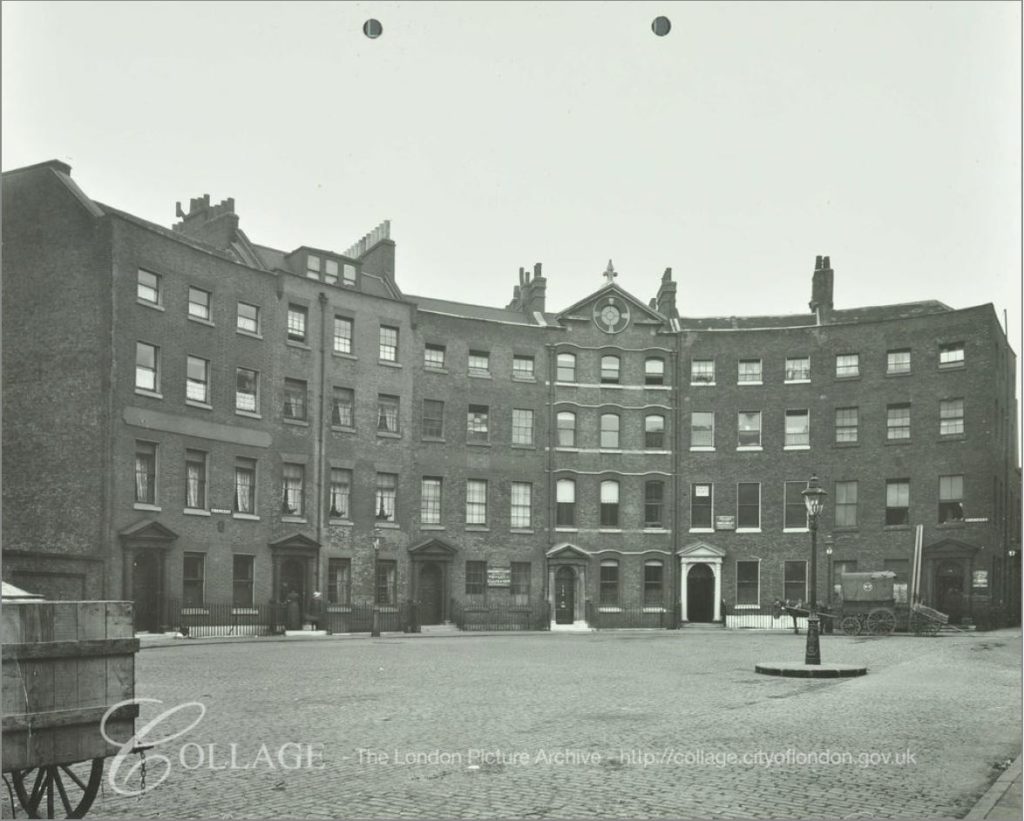
The final part of the Dance scheme was The Circus, seen at the bottom of the OS map; it too was severely affected by bombing but was not rebuilt and eventually succumbed to road widening. The full story is here
http://www.commuterconsultant.com/2014/03/lost-london-circus.html
Was Hessel Street E1 off the Commercial Road named after Dr Henry James Bernard Gottfried Hessel?
I remember the Seamark Club in The Crescent, digs for those using the John Cass College School of Navigation. It had a very accurate design of a navigation buoy high up on the front wall.
I remember the run of warehouses in The Crescent as late as the 1970s
I know that parts of the area were once owned by the East India Company, although I’m not sure exactly which bits. Certainly it included the land fronting onto Trinity Square on which the Port of London Authority headquarters was built in the 1920s but I think there was probably more. (The EIC also had a lot of warehousing space just to the east of Bishopsgate).
My mistake above, para 3 ‘I remember the run of warehouses in The Crescent as late as the 1970s’
‘The Crescent’ should read ‘The Circus’.
For properties in EC3 see the British Library which holds a comprehensive collection of fire insurance plans produced by the London-based firm Charles E. Goad Ltd. dating back to 1885.
See here: http://www.bl.uk/onlinegallery/onlineex/firemaps/england/london/itov/mapsu145ubu22u3uf056r.html
I worked in Walsingham House on the corner of Seething Lane and Crutched Friars in the early 1960s. When they were excavating the site between that building and the railway line they discovered many bodies buried. Possibly from the plague – I cannot remember. Probably the site where the Hilton is now. I well remember the tunnel which ran from underneath the railway bridge through to the station. The aromas were amazing – spices etc. But I would not like to pass via that way today – probably closed anyway.
It’s been nearly 20 years since I worked near there and regularly had to attend an insurance Underwriters office in The Crescent. I recall that a building had a connection with Tubby Clayton of Toc H in that area.
Both 6 & 7 were in Toc H’s hands at one time. 6 was known as Wakefield House and was used as various offices (This was 40s/50s). 7 was Seamark, a merchant navy hostel which Toc H had some involvement with but in the 70s they took it over and it became a hostel for young Bangladeshi boys, run by Peter East. Closed about 1982 I believe.
In the late 70s, I lived in a flat at the top of number 6, after moving from 43 Trinity Square. Both were owned by the Wakefield Trust: 43 Trinity was a hostel, operated by Toc H with Peter East as warden. A lovely, generous man. The flat at the top of 6 The Crescent, was used by All Hallows Church, for clergy. It was not in use, so I was allowed to move in. Whilst living on Tower Hill I was elected as a Central Councillor for Toc H and then a member of the national committee. That took me out of international banking and into the voluntary sector. A big change in life.
I’m working on a blog about Toc H on Tower Hill at present. Its fascinating but I have strayed far off my original remit as the whole area is full of history
How interesting…I worked in One America Square (entrance on Crosswall) for a couple of years (2013/2014) and was fascinated by how it had been built round Fenchurch Street station and the railway….I was in the lift one lunchtime after getting my sandwich, with 4 or 5 other people, when the lift doors opened….to a solid brick wall!! One of my fellow passengers started to panic and thankfully the doors closed quickly enough and we went on our normal journey. It appears that this was the floor to the station level and should not have been able to open. I admit that it was an unnerving experience and I was grateful that I wasn’t alone! I think they refurbished the building not longer afterwards including the lifts! The conference centre in the basement is pleasant and does display the section of London Wall very well.
Maybe Alan Whytock refers to French Ordinary Court which reeked of wine in the 1970s.
Still open but relatively odour free.
Two of the Crescent houses were occupied, in the 70s, as hostels and were linked through to houses in Trinity Square. Both were owned by the Wakefield Trust and administered by Toc H which had an office in Crutched Friars. The location is due to the proximity of All Hallows Church, the church, at one time, of Rev Tubby Clayton, founder of Toc H.
I moved into 43 Trinity Square, now the home of the All Hallows priest, in the mid 70s, in order to run a Toc H project with children in Spitalfields – and stayed., later moving into an All Hallows flat on the top floor of one of the Crescent houses. Below the flat was a solicitors. Moved out in 79. Interesting and happy days as I worked in the City.
I thought I recognised the name, Thank you a most enjoyable read. I research names of people buried in the Exeter Dissenters Graveyard. One name was Catherine Hippius wife of Jacob Gotfried Hippius a merchant who at one point in the mid to late 18th century had an address in America Square. Strangely too he and his wife are related to Matthew Flinders who you mentioned a few weeks ago. So pleased they found his remains. Attached a link to my write up for the graveyard.
http://www.edgt.org.uk/uploads/3/4/6/9/34695614/69_-_hippius_rev_july_2017.pdf
The destruction of Dance’s scheme is a very sad story. One of my great-greats, the architect N S Joseph, was born 1834 in one of the two surviving houses in the Cresecent. The destruction, shown in your OS map, begun by the vandals constructiong the Circle Line, was contined with vigour by the Luftwaffe followed by the City planners who now in their wisdom have decided it is a Conservation area. I’d not realised that one of the Crescent houses had been ‘Edwardianised’, the current restoration takes no account of this.
If you can’t visit have a look in Google maps in birds’ eye view to see the vandals at work.
Another great article. K Thanks and keep going
Thanks. This is yet another nook I’ve missed exploring, as I wander through the City during visits, to which you’ve alerted me. And thanks for your photo of the Crescent and Chris Rogers’ comment about The Circus. The railway underpass leading to the Crescent reminds me of a City favorite: French Ordinary Court, running from Crutched Friars out to Fenchurch Street. I make a point of walking through there when I’m in the vicinity.
My ancestors lived at no. 2 America Square in the late 18th century, and my great-great-grandfather was born there in 1796. I’ve often visited America Square and tried to imagine what it might have looked like all those years ago. Your article makes fascinating reading, thank you!
also my 8 x times grand father lived here died 1807 william mander and also owned 43 the cresent
Very enlightening on an area I knew nothing about.
Thanks again for another interesting post
I know a little about the “earlier” life of America Square. In about 1794 – 1801 Nathaniel Whalley (my 3xgr uncle) lived at No12 America Square, Minories (records of Sun Life Insurance). He was married to Martha Constable an older sister of John Constable the famous artist who was an impoverished young student at the Royal Academy of Art at the time.(1801). Martha made sure he didn’t starve and had him to dinner at America Square most nights. We learn this from the diary of Nathaniel’s father Daniel who when visiting his son Nat in April /May 1801 records ‘that Mr John Constable frequently with his sister and her family at Minories’ and at least on 11 other occasions ‘ that he dined at his sons and Mr. John Constable was with us.’
How fascinating to think that our ancestors were neighbours over 200 years ago! My 3 x great-grandfather, John Henry Munnikhuizen, and his family were living in America Square from the mid-1790s. John Henry died in 1801 but the family continued to live there for several years afterwards.
You are so lucky to have your ancestor’s diary, what a wealth of information that must contain. Strange to think that John Constable was dining in America Square when my family were just a few doors away!
I doubt if you ancestors would have been impressed as Constable was just a lad then and did not become famous until late in his life. The Diary is held in the John Constable collection at The Suffolk Records Soc. It would be great to be able to see it written in my x great grandfather’s own hand but that is difficult as I live in Australia. The parts concerning John Constable (there are more) can be found on line.
My father was a Merchant Seamen who attended Sir John Cass College studying for his Extra Masters. My parents were subsequently married at All Hallows by the Tower and their reception was held at the Seamark Club where he had accommodation in 1958